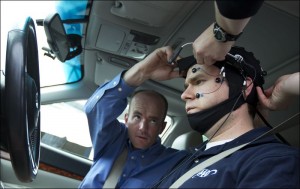
April 21, 2014 | Posted in Distracted Driving, Podcast Episodes | By Traffic Safety Guy
Comments Off on 19 – Distracted Driving—It’s All In Your Mind
Podcast: Play in new window | Download
Subscribe: RSS
April is Distracted Driving Awareness Month and this episode is part three of a four-part series examining distracted driving, and what we need to do to be safer drivers.
Recent research of cognitive distractions found a person’s mental focus does impact driving. Russ Martin, Manager of State Relations at AAA discusses the research, what it means and provides tips on how you can be a safer driver.
Cognitive Distractions are Real
Distracted driving comprises one or more aspects: manual, visual, and/or cognitive. A cognitive or mental distraction has been difficult to study because it all happens within the brain.
Hands-free cell phones, Voice-to-Text software are designed to make it easier to be connected with the world around us. Yet, these same helpful technologies put us in danger when we drive.
Partnering with researchers at the University of Utah, AAA found a way to look into our brains and determine that hands-free technologies used in the car dangerously divert our attention from the vital task of driving.
Groundbreaking Research
For the research, participants wore a skullcap with electrodes attached that were wired to a monitor allowing researchers to examine their brain waves and study mental workload. Participant then ‘drove’ in a simulator or a specially equipped car on the road, performing a number of activities that include:
- Changing the radio station
- Using a cell phones, both hand-held and hands-free
- Sending an email with voice-activated technologies, and
- Doing a math problem.
Reaction time and eye movements were captured with cameras and other electronic devices.
In Phase One of the two-phase study, researchers created a rating scale for cognitive distractions using a scale of one to five, with five being the most distracting type of activity. Changing the radio station was determined to be a one, the least cognitively distracting activity. The use of speech-to-text technologies, such as features allowing drivers to respond to text messages or emails, was rated three, indicating a high level of mental distraction. Phase two of the study is taking an in depth look at the voice-activated technologies and examining what can be done to make them safer.
Creating New Risks?
Automakers are designing devices that allow individuals to keep their hands on the steering wheel, and use voice commands to interact with the car. But this is not limited to carmakers. For example, Apple just came out with Apple CarPlay calling it “a safer way to use your iPhone in the car,” and Google has developed Google Glasses. Companies are reducing manual distractions; but increasing cognitive distractions. This does not make it safer.
Cognitive distractions are just as dangerous, if not more dangerous. Once both phases of the study are done, it is hoped automakers and others will take the research into account in their designs.
However, it is important to acknowledge that others also share the responsibility in creating these new risks; and that is all of us. Customers are asking carmakers for these gadgets, the companies oblige us, and then we use them. A high percentage of AAA members (and non-AAA members) believe distracted driving is dangerous, but still they do it. Driving while chatting on a cell phone (hand-held or hands-free) or sending a text message is distracted driving. It’s a “Do as I say, Not as I Do” attitude. As Russ states, we have “heroic” assumptions of our own driving abilities.
Distracted driving kills and it injures. It isn’t selective, choosing only women, or only men. It doesn’t distinguish between the poor and the rich, or the young and the old. It is an all-encompassing killer. Fortunately, there are ways to help protect you from this killer.
What Can You Do?
First and foremost, when you are in the driver’s seat, the most important thing you can do is focus on the driving. Keep in mind:
- When driving, it is not a time to stow away loose items, to dress or to groom.
- Before driving somewhere, make sure your children are secure with their safety belts fastened, and pets are protected with a harness or other safety device.
- If you have a passenger in the car with you while driving, don’t be afraid to ask for help.
- Eating while driving is distracted driving, so the best course is to always stop and eat. But if you’re going to do it, eat smart snacks such as chips or carrots. Don’t eat food that creates a mess or is difficult to eat, like soup or something that requires two hands.
As Russ stated, there is so much that can be done beforehand to square away everything before even pulling away from the curb. Being proactive could save your life and the lives of your passengers.
What are you doing to reduce your distractions?
Related Links:
Websites:
Research:
- AAA Research – Measuring Cognitive Distraction in the Automobile
- Traffic Injury Research Foundation (TIRF) Research – Driver Distraction and Hands Free Texting While Driving




